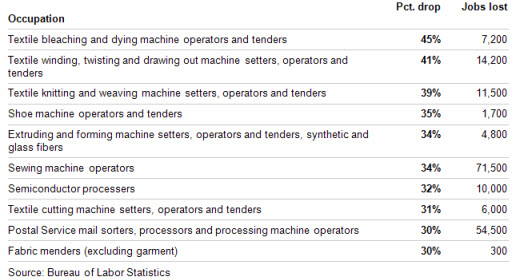The Iceman cometh….and the Iceman went away.
More than 25 percent, or over 2 million, of the jobs that were erased from the economy over the past two years are probably gone for good.
Going back to the beginning of the 20th century, we’ve seen dozens of occupations disappear. As computers and automated systems increasingly take the jobs humans once held, more and more professions are becoming or are now extinct.
Consider the iceman. Before electric refrigerators became pervasive in the 1940s, iceboxes needed to be stocked regularly with ice to keep food cold. With advances in manufacturing and automation, the need for deliverymen to haul 25 to 100 chunks of ice into homes disappeared.
Anyone remember the lector? Probably not unless you lived nearly 100 years ago. Lectors In the early 1900s read newspapers and political tracts aloud to factory workers. The occupation was particularly popular in cigar makers in Florida and New York City. Today a lector would easily be replaced by two ear buds and an iPod.
Other jobs used to employ thousands of people that have disappeared during the latter part of the 20th century include elevator operators, copy boys, bowling alley pinsetters, river drivers, lamplighters, milkmen, switchboard operators, typists, typesetters, and telegraph operators.
The loss of jobs due to occupation extinction is expected to continue unabated over the next decade. At least 50 percent of workers in the American job market today work in people-powered industries like fast-food restaurants, delivery companies, hospitality, and warehousing. All of these jobs are prime targets for robotic replacement, says Marshall Brain, the author of “How Stuff Works.” They will likely fall victim to automation and globalization just like textile jobs did beginning in the 1970s.
Brain wrote in his essay “Robotic Freedom” that in 2003 we saw the deployment of automated checkout lines in retail stores. By 2015 we will start to see voice-recognizing robots helping customers in these stores, inventory-shelving robots putting the products out, cleaning robots sweeping the floors and parking lots, and cart robots bringing the shopping carts back into the store.”
Job extinction won’t stop there. Other occupations that will decline the most for through 2018, measured by percentage change in jobs, according to Bureau of Labor Statistics include the following:
But all the news isn’t bad.
In fact, Joe Watson, CEO of Without Excuses and StrategicHire, believes that “by learning a new skill or translating your existing skills to a different field, you will be employed for as long as you want, no matter what shape the economy is in.” Watson recommends that job seekers take control and “go where the growth [industries] are.”
According to the Bureau of Labor Statistics cited by Watson, service occupations are projected to have the largest number of total job openings. Here are a few of the industries and projected growth numbers.
- Health care: 3 million new jobs created by 2016.
- Biotechnology: 48,000 new jobs by 2016
- Education: 479,000 new jobs by 2016
- Green energy: 5 million new jobs by 2020
- Government: 1 million new jobs by 2016
- Information technology: 872,000 new jobs by 2016
- Accounting: 150,000 new jobs created every year
- Customer service: 545,000 new jobs created by 2016
- Engineering: 160,000 new jobs created by 2016
- Finance: 147,000 new advisor and analyst jobs created by 2016
- Firefighting: 43,000 new jobs created by 2016
- Insurance: 148,000 new jobs created by 2016
- Social work: 132,000 new jobs created by 2016
Read more – Download pdf version of What Jobs Won’t Return.
Previously published Business2Business, April 2010

